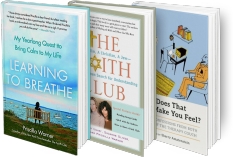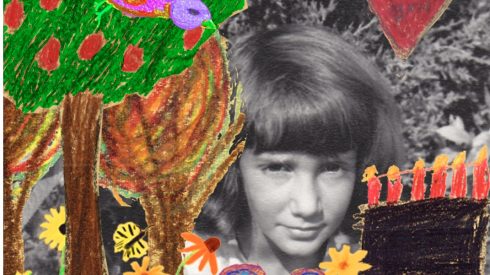
We’re Not Who We Think We Are
I was an unhappy child.
Or at least that’s what I told myself for decades because of all the somber black and white photographs my mother took of me back then. “Get this kid some Prozac!” I imagine someone might have suggested to her had anti-depressants been invented in 1961.
I’d constructed a sad narrative about my childhood in all the writing I did and in all the therapists’ offices I visited, because there had been plenty of things to cause me pain. My parents’ marriage wasn’t sustained and loving, so they couldn’t create a truly loving home. They both battled depression, and mental illness ran through my father’s family like wildfire. Our family business went bankrupt after my father had worked long hours to keep it afloat.
But a treasure trove of drawings I discovered a few years ago changed that story of my life.
Literally.
*
My mother struggled with Alzheimer’s for thirteen years before she died. That gave me just about enough time to clean out the four different storage units she’d owned, and the three floors of her house full of antiques and oddities, artwork and kitschy collectibles. The weirdest thing I discovered during my purging was a box of strangers’ dental molds (which my mother – an eccentric artist – must have been saving for an art assemblage of some kind…)
And then one day, as I was going through her cluttered basement studio, I came across a battered cardboard portfolio hidden in the back of a closet.
I assumed that it was full of my mother’s art, which I didn’t have the patience to sort through, so I shoved the portfolio into the trunk of my car and stored it in a hallway closet back at my house.
My mother’s long, grueling illness took up a lot of my energy, and it wasn’t until two months after her funeral that I decided to go through that closet, while I was looking for some of her old paperwork.
And when I opened up the long forgotten portfolio, I was shocked at what I found inside: a pile of pristine children’s drawings, done on manila paper, which had yellowed a bit with age.
I hadn’t laid eyes on any of this in fifty-five years.
In fact, I had absolutely no memory of ever creating it.
However, my mother had labeled many of the pieces with my name and age: Priscilla 7 yrs old. And when I spread some of the drawings out onto the floor of my bedroom, I was stunned.
I had been a happy child!
Or a happier child than I’d ever imagined myself to be.
The art I’d unearthed was full of color and life; pretty girls raked fall leaves, butterflies flew over tidy, colorful houses, and flowers blossomed under bright yellow suns.
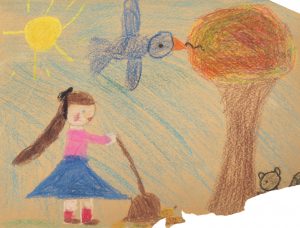
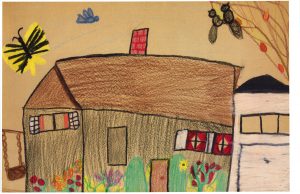
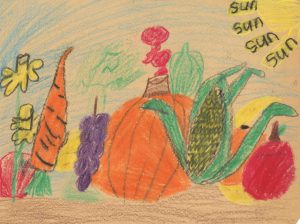
I had known joy.
What a revelation!
I wasn’t who I thought I was!
None of us are, I suppose.
And that’s perhaps the most exciting discovery we can ever make. The possibilities of who we can be in any given moment are countless. There are endless opportunities for us to grow, and my childhood art allowed me to see that.
I’ve published two books, both spiritual memoirs. My teachers have included a Tibetan monk, a mystical rabbi, an imam, a minister, an Ayurvedic healer, therapists, a neuroscientist, and numerous Buddhist scholars.
At the age of sixty-six, however, I have finally realized that my seven year old self can be a wonderful, wise guide to life in the present moment, teaching me as much as any other learned human being.
I’m making art with my childhood art.
I’m scanning my childhood drawings and making digital collages by dropping them into my recent IPhone photos. My past and my present are colliding in a magical way. A king and queen with pointy crowns ride the subway with me. A juggler and clowns prance around Times Square. A snowman watches over my favorite beach, like a happy lifeguard.
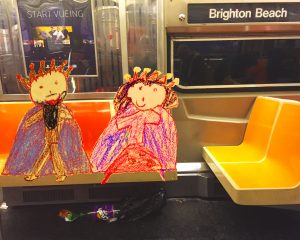
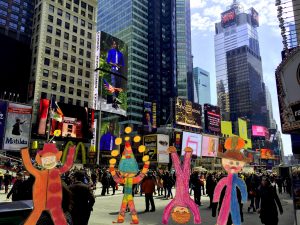
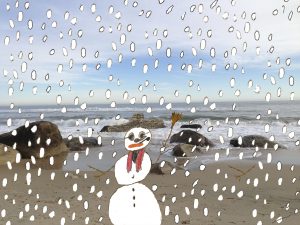
A Buddhist friend once taught me about the fluidity of time – that there is no such thing as a past, present and future. That it’s our brains that apply labels and time codes to what we see, feel and hear during the course of our lives.
My first meditation teacher – a young Tibetan monk – urged me to try and see the world with a child’s mind, as though for the very first time, without getting caught up in the angst that colors our experiences as ruminating adults. So I’m trying to do that with my artwork.
Joyfully.
I’m not an art therapist, but I’ve got to assume that when I made all those drawings half a century ago – of bright yellow suns, happy blue birds finding wiggly worms, and girls in bright pink blouses and red socks raking fall leaves – I was tapping into something deep inside of me.
So maybe happiness is tucked inside each and every one of us, put there by God, or Yaweh, or Jesus, or Buddha. Or some other mysterious force.
And maybe that happiness is like the joyful yellow suns I drew on so many pictures back then. I imagine all those suns beaming down on me now, as I work with all that colorful art, creating new, healing narratives.
“What kind of a life did I have?” I once asked a compassionate psychiatrist I was seeing at the time. “Did I have a good life or a hard life?”
This doctor and I had covered so much during our sessions – the mental illness in my family, my troubled childhood, my panic attacks, and the loving marriage and family I’d somehow managed to finally create for myself.
“You had a life,” said the therapist whose own days on earth would soon come to a tragic end.
And now I have one with beautiful illustrations.
Different than the life I once thought I had.
And I’m basking in the bright yellow sunshine of my childhood.
